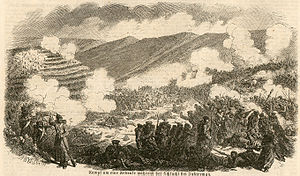Battle of Inkerman
| date | November 5, 1854 |
|---|---|
| place | Inkerman |
| output | Allied victory |
| Parties to the conflict | |
|---|---|
| Commander | |
| Troop strength | |
| 16,000 men | 35,000 men |
| losses | |
|
5,700 dead and wounded |
11,800 dead and wounded |
Olteniţa - Akhaltsikhe - Başgedikler - Sinope - Cetate - Silistra - Nigojeti - Tscholok - Odessa - Kurekdere - Petropavlovsk-Kamchatsky - Alma - Sevastopol - Bomarsund - Balaklava - Inkerman - Yevpatoria - Taganrog - Çorğun - Kars - Tschernaja - Malakoff - Kinburn - Third Paris peace
The Battle of Inkerman was a military confrontation on November 5, 1854 in the Crimean War between Great Britain and the French Empire on the one hand and the Russian Empire on the other and ended with an Allied victory.
Background and starting position
On September 14, the allied British, French and Turks landed in Yevpatoria in the Crimea . Shortly afterwards they enclosed the Sevastopol fortress and besieged it for about a year . An attempt by the Russians to end the siege by a relief army brought in from Bessarabia led to the Battle of Balaklava on October 25, 1854 . The battle ended in a draw and did not lift the siege.
Structure of the Allies
- British Army ( Lord Raglan )
- 1st Infantry Division ( George, 2nd Duke of Cambridge ) 1,331 men
- 2nd Infantry Division ( Pennefather ) 2,956 men
- 3rd Infantry Division (Richard England) 281 men
- 4th Infantry Division ( Cathcart ) 2,217 men
- Light Division ( George Brown ) 649 men
- French Army ( Bosquet )
- Bourbakis Brigade 2,115 men
- Brigade d'Autemarre 3,670 men
- Troops under Monet 2,432 men
Troop strengths express how many soldiers the units used in battle, not their nominal strength.
Outline of the Russians
The battle
On November 5, 1854, the trapped Russians attempted a sortie against the British troops standing at Inkerman . They worked in three sections. While General Gorchakov was supposed to bind the French with 22,000 men at Balaklava, General Fyodor Ivanovich Soymonov and General Prokofij Jakowlewitsch Pavlov attacked the British with a total of 35,000 men at Inkerman.
The Russians tried to flank the British by occupying the hills at the northern end of the British position. The British then turned their front line and went on the defense. For about three hours, around 8,000 British defended their position against around 30,000 Russians in bitter fighting. Then the French Zouaves and the Foreign Legionaries attacked the Russians again in the flank and forced them to retreat.
The Allies succeeded in this way to prevent a Russian breakthrough and to continue the siege, but they suffered very high losses. The fighting British units lost more than a third of their men, including the commander of the division bearing the brunt of the battle, Major General George Cathcart .
literature
- German Werth: The Crimean War , Frankfurt / M. 1989, ISBN 3-548-34949-8
- Alexander Rodger Battle Honors of the British Empire , 2003, ISBN 1-86126-637-5
- AW Kinglake, The Invasion of the Crimea (nine volumes), London 1863–87. (Reprinted by Naval & Military Press, May 2003. - ISBN 978-1843424970 )
